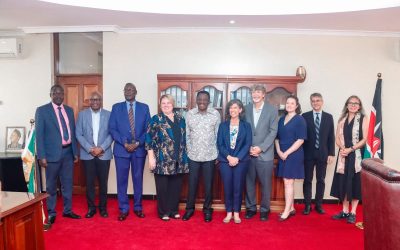
The US Centers for Disease Control and Prevention’s (CDC) partnership with the Siaya County Government to continue until the high burden of HIV, TB, and Malaria reduces to lower rates. The partnership has registered impressive results on Prevention of Mother-to-Child HIV Transmission, which currently stands at 4.3 per cent down from 21 per cent. According to the Kenya Estimates of 2023 by the National Syndemic Diseases Control Council (NSDCC), Siaya County was placed with the lowest mother-to-child HIV transmission rate from 21% to 4.3%, compared to the national rate of 8.6%.
Speaking in a meeting with Governor James Orengo, the CDC Global Health Center Director Dr. Kayla Laserson cited that they are happy to see positive progress realized from the interventions of the partnership and they seek to strengthen existing gaps on the programs to reduce the negative health indicators and set up robust sustainability strategies. "Siaya county has been very instrumental on research work targeting Malaria, TB, and HIV. Its results have helped develop key policies that was transforming health sector and that's why we are here to identify gaps, priorities that will support for the gains achieved be sustained,” said Dr. Laserson. "We want to appreciate the efforts of our partners for working closely with our government to reduce the negative health indicators on TB, Malaria and HIV. CDC/KEMRI interventions has significantly reduced HIV scourge in Siaya on Children,” she added. Dr. Kayla added that many interventions designed and executed in Siaya are now global policy and it’s Siaya and Kenya that is promoting global public health.
Governor James Orengo on the same note appealed to the health partners to continue the partnership program on the diseases and consider expanding their support base so as to facilitate other diseases burdening the county. “We hope that the program will continue because we are much behind our targets in terms of healthcare. Matters to do with HIV is one of the biggest success stories especially on PMTCT,” said Orengo. Orengo also attributed the achievement to great support from KEMRI/CDC. “The 19 percent is still high compared to neighboring counties but we hope with continued cooperation and collaboration we’ll be in a much better place,” noted Orengo.
Orengo faulted National Government for starving counties, especially the health sector where huge resources are held yet they concentrate on policy issues. He also added that health records are fully digitized with viable digital system put in place that enables easy trace of the patients on treatment and statistics on the progress of the healthcare activities. Currently, Siaya's HIV prevalence is 13.2 percent which is equivalent to 97,000 patients who are on care. Previous studies conducted by Human Demographic Surveillance Systems (HDSS), the prevalence of HIV among the fishing community is as high as 31 percent despite the high epidemic in this country.
According to CDC Associate Director Dr Appolonia Aoko, we have done well in terms of achieving 95:95:95 goal. “This year we are conducting a National survey KEMPHIA and would know the updates,” she said. According to UN-AID estimates, statistics indicates that Kenya is in the green bracket-one of the countries that is working towards achieving the epidemic reduction. "The prevalence on HIV is high in females compared to males which is about two times high, so we have a national prevalence of 3.7 percent and females are as high as 5.3 percent and males are 2.6 per cent," said Dr. Aoko.
“Our viral suppression is good and it's above 96 per cent and target was 95 percent. However, we appreciate that some population in children and adolescents have not achieved that but as a country we are proud of hitting 90 percent mark which is a significant achievement in a country that was at 60 percent suppression," said Dr. Aoko. “Therefore, as CDC, we support 60 percent of people living with HIV in this country. Over 800,000 people and half of the population come from Western Kenya. In Siaya the problem is four times as high," she added.
Siaya HIV coordinator Silvia Imbuye says for sustainability, they have embraced Government to Government (G to G) strategy where six sites are piloted. “Currently we have 49 sites being supported by G to G which is a very strong stride towards the sustainability. In the 97,000 patients under care in Siaya almost a third are patients handled through G-to-G facilities,” said Imbuye. She added that through the department of health, they are doing mentorship programs as part of sustainability initiative.
